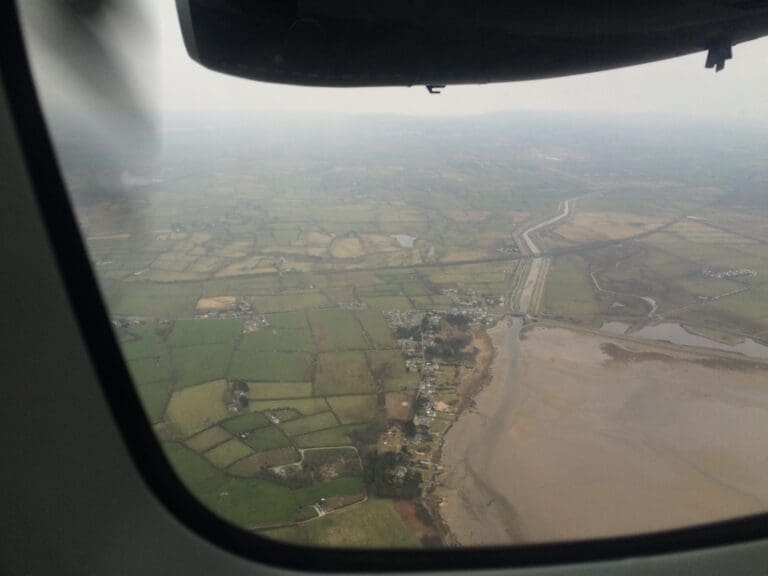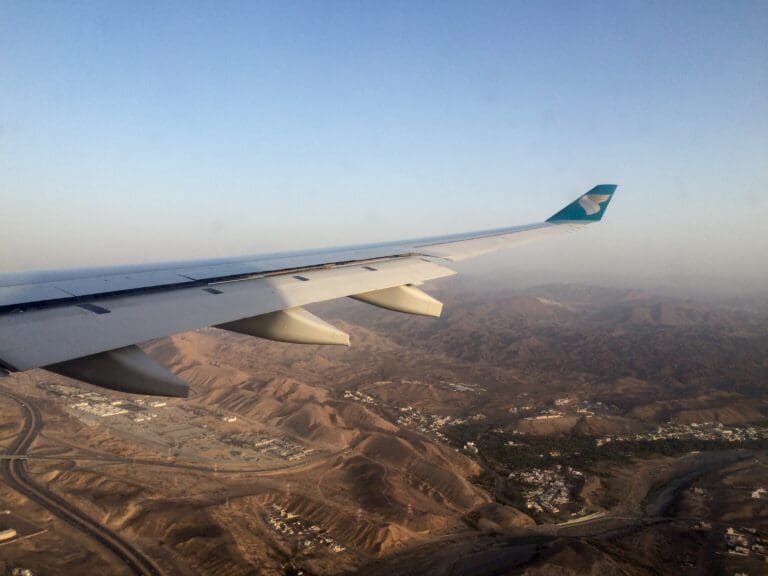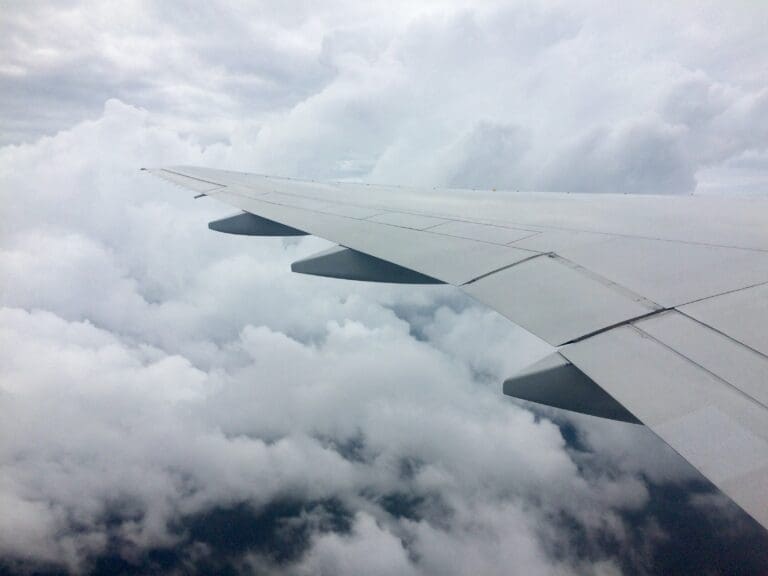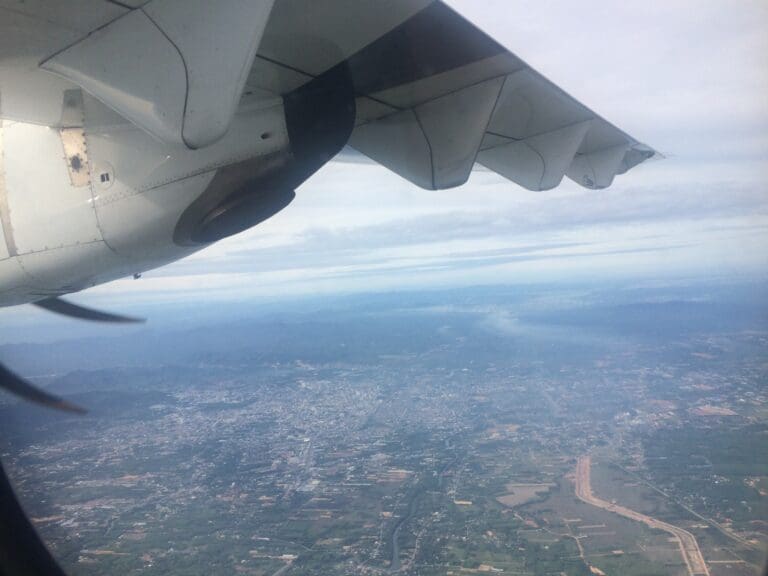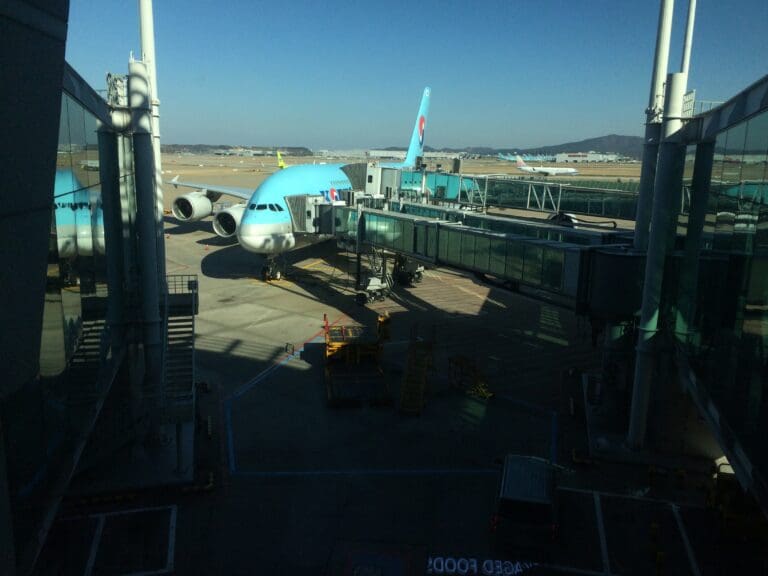Riding the Rare Babybus from Birmingham to Paris: Air France A318 Review
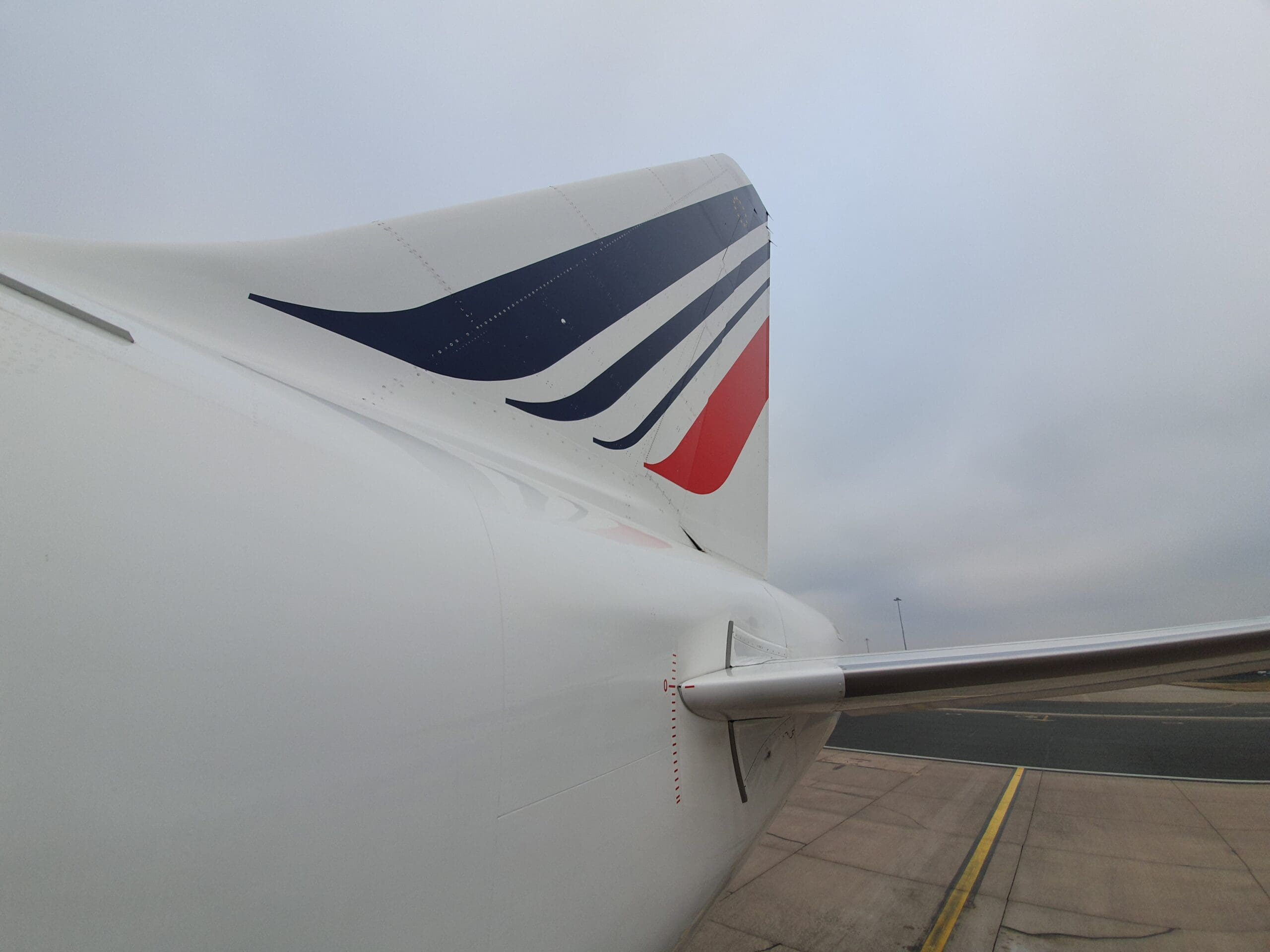
You can read all the background information for this flight, and my outbound leg from Paris CDG to Birmingham on a Flybe Embraer 175 here.
Check-In
Online check-in is possible for most Air France services up to 30 hours before departure. Being a diehard enthusiast, at 0845 on New Year’s Eve, I opened Air France’s app in the hope that I would be able to check-in. Anticipating no issues, much to my surprise, I found that I had already been automatically checked in and assigned Seat 11A. Whilst thankful to the check-in gods for the fact I had received a window seat, unlike the Flybe-operated leg of my itinerary, my seat could be changed without paying an additional fee so I opted to shift over to Seat 17F. This would offer a slightly less obstructed view of the wing, a nice sunset and good views of Paris were we to land into the east.
In addition, the day before departure, passengers can download several complementary publications via the Air France Play app. After installing this app, I entered my booking reference and name before being informed of my allowance – two magazines and two newspapers. This of course excludes Air France’s own publications. When it came to content, a more than reasonable selection of literature was offered – 107 magazines and 60 newspapers to be precise. Alongside this, an ‘unlimited’ music allowance was offered – whilst this may sound impressive, the selection of tunes offered was rather limited, featuring only the airline’s monthly playlists from September to December 2019, each with four tracks, as well as a couple of two meditation playlists.
The Journey
The next morning, after a relatively calm New Year’s Eve, my festive week in my hometown of Sheffield came to an end and I gathered up my belongings before squeezing them into a small suitcase. As far as airports go, Birmingham Airport is relatively easy to reach from Sheffield, with the train journey from Sheffield to the airport’s on-site station taking about an hour and a half and involving a single change, whilst direct National Express coach services also connect the two. Whilst initially intending to take the train, assuming good traffic conditions, this journey takes approximately an hour and a half. However, travelling on New Year’s Day, we decided to leave a little earlier than perhaps necessary, departing hilly Sheffield at 1100. Speeding southwards, we soon reached the M1, passing East Midlands Airport around an hour after departing before turning off onto the M42 towards Birmingham. After exactly ninety minutes in the car, the slightly grim skyline of the airport came into view consisting of the tops of the airport’s multiple hotels and the grey multi-story car parks that flank the terminal, thereby heralding our arrival at Birmingham Airport.
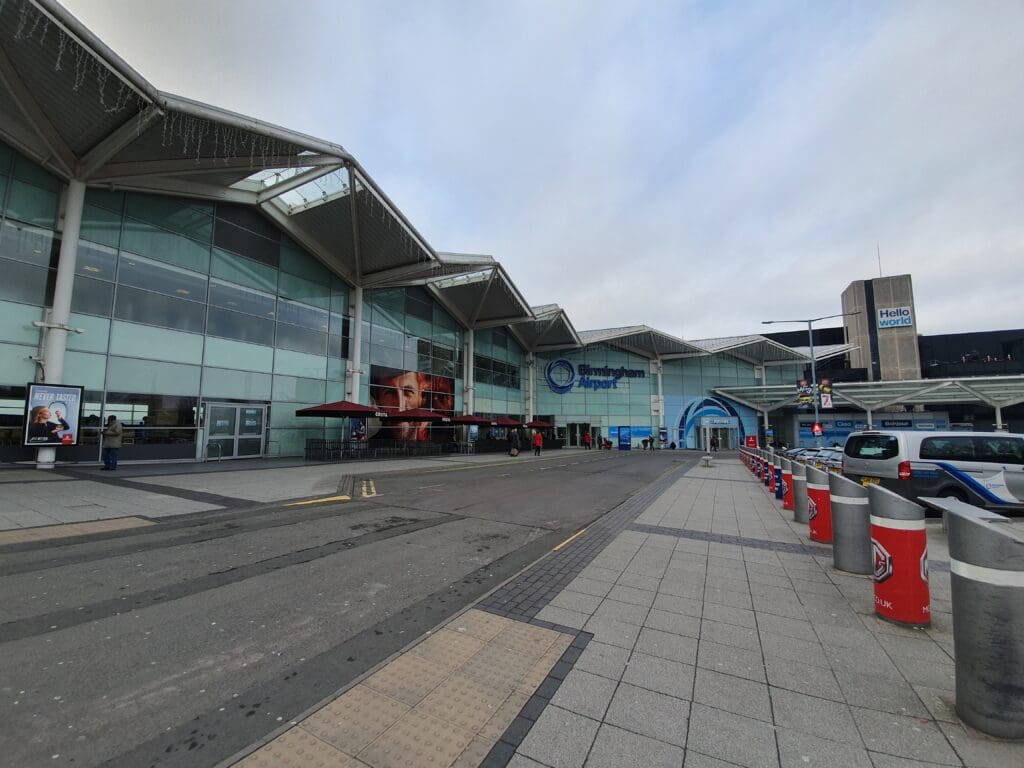
From the outside, Birmingham Airport’s terminal is nondescript and unimpressive, with little to distinguish it from any other British regional airport terminal bar the signage. Not needing any great amount of time to admire the terminal’s architectural splendour, I soon made my way inside. Since the closure of the viewing gallery and aviation enthusiasts’ shop, the landside portion of the terminal does not feature any particularly noteworthy features. That is not to say that there is anything particularly bad about this, with this being home to a fair number of shops, cafés, bars and restaurants, where passengers and non-passengers can pass the time. Importantly, that lunchtime, the terminal seemed to be in a fairly clean and tidy state, whilst I was also a little surprised by the low number of passengers.
Hoping to get a paper copy of my boarding pass, I headed over to the empty check-in area in search of a self-service check-in machine. Upon reaching the check-in area, I soon found a vacant check-in machine and was able to print out my boarding pass sans issue. This took around a minute, which was perhaps slightly longer than expected, something which came as a result of having to scan my passport multiple times before this was recognised. Once I had my boarding pass in hand, I had no reason to remain landside and thus made my way up the escalators to the entrance to the security.


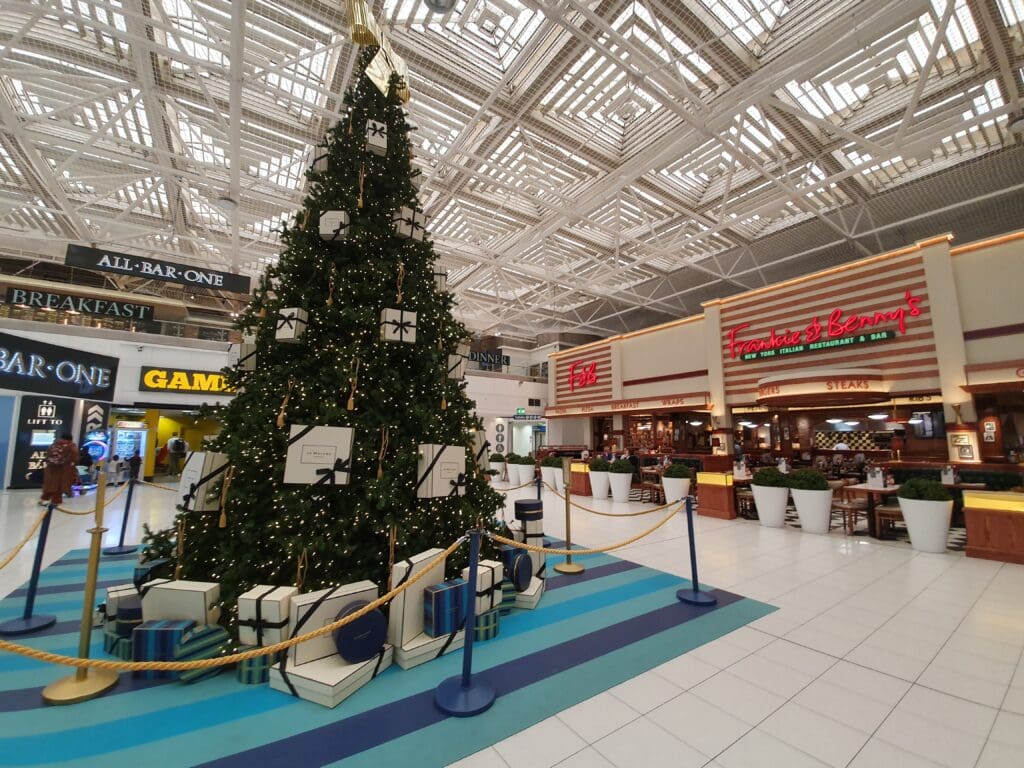
Seeing as Birmingham’s morning rush was well and truly over for the day, after scanning my boarding pass I was able to walk straight to the security checkpoints. Whilst queues there were only minimal, it did take some time to get through the checkpoint. Furthermore, the staff there were most certainly not in the festive spirit, being rather snappy and even a little rude! Fortunately, having followed the rules, I made it to the airside portion of the terminal without any issues or the need for additional checks, with the entire process taking about five minutes.
As with many British airports, once through security, passengers are required to walk through the local duty-free shop before reaching the main waiting area. Not needing to make any purchases, I steamed through duty-free and reached the main waiting area where a host of cafés and shops could be found. Unlike my previous visits to the airport – all of which had been during Birmingham’s morning rush, the terminal was pleasantly quiet. Needing neither refreshment nor some last-minute retail therapy, I headed straight through to the newer pier which serves to be the only place in the airside portion of the terminal that offers decent views of the happenings on the apron, taxiways and runway outside.
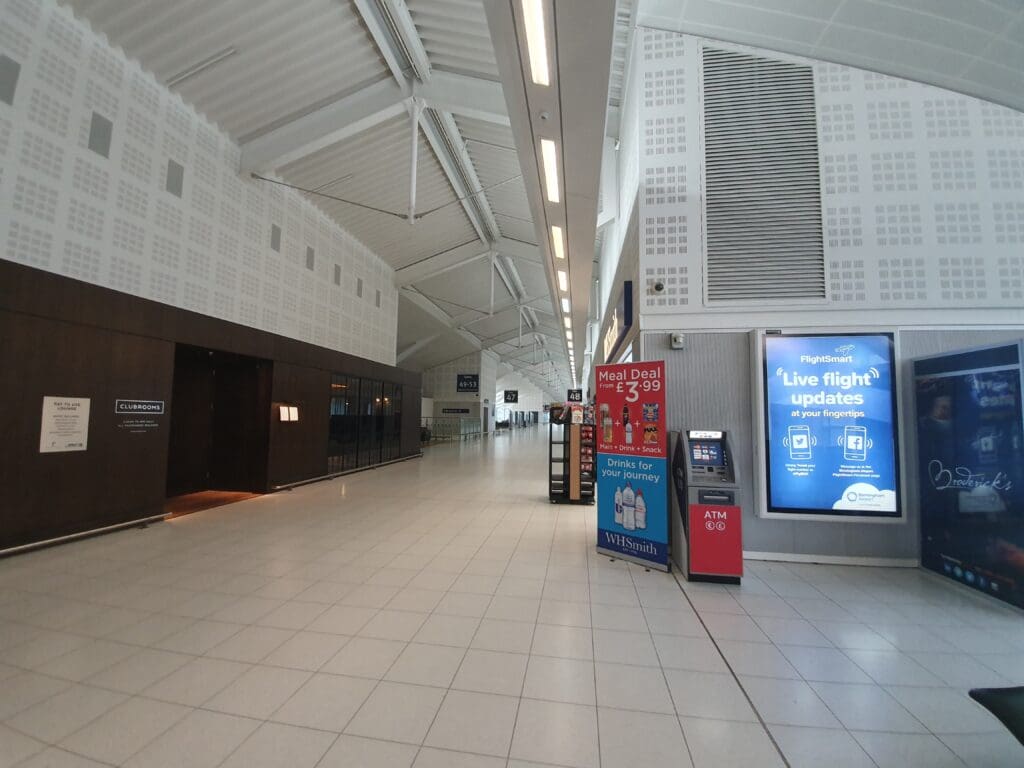
Walking along the pier, I stopped to admire Birmingham Airport’s largest visitor, an Emirates Airbus A380 which at that time was being readied for its return leg back to Dubai, as well as a TUI Airways Boeing 787-8 Dreamliner that would soon head off on a long flight to the Malaysian island of Langkawi. Aside from these widebody jets, a small yet diverse selection of airliners could be seen at the stands below. These included an Aer Lingus Airbus A320, Austrian Airlines Embraer 195, Luftfahrtgesellschaft Walter Dash 8 Q400 (operating for Eurowings), KLM Cityhopper Embraer 190 and Vueling Airbus A320 bound for Dublin, Vienna, Dusseldorf, Amsterdam and Barcelona respectively. Meanwhile, at the remote stands, an army of leisure aircraft could be seen parked up for the bank holiday. This collection consisted of 10 Jet2 Boeing 737-800s alongside a TUI Airways Boeing 737-800 and Boeing 787-9 Dreamliner.
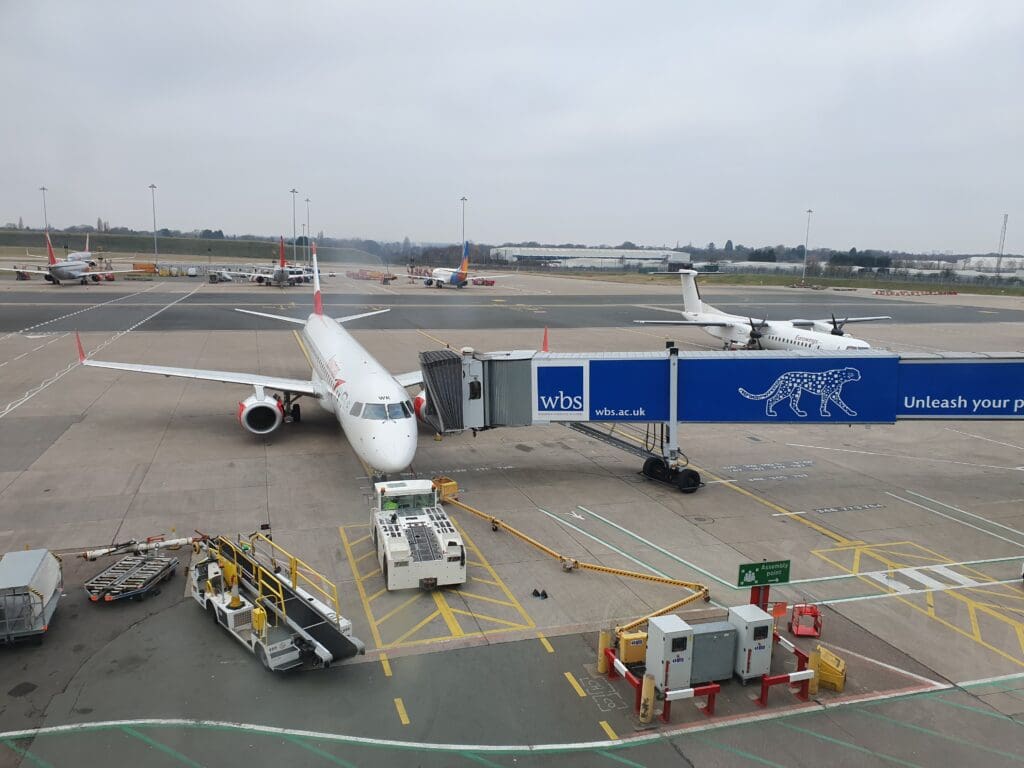
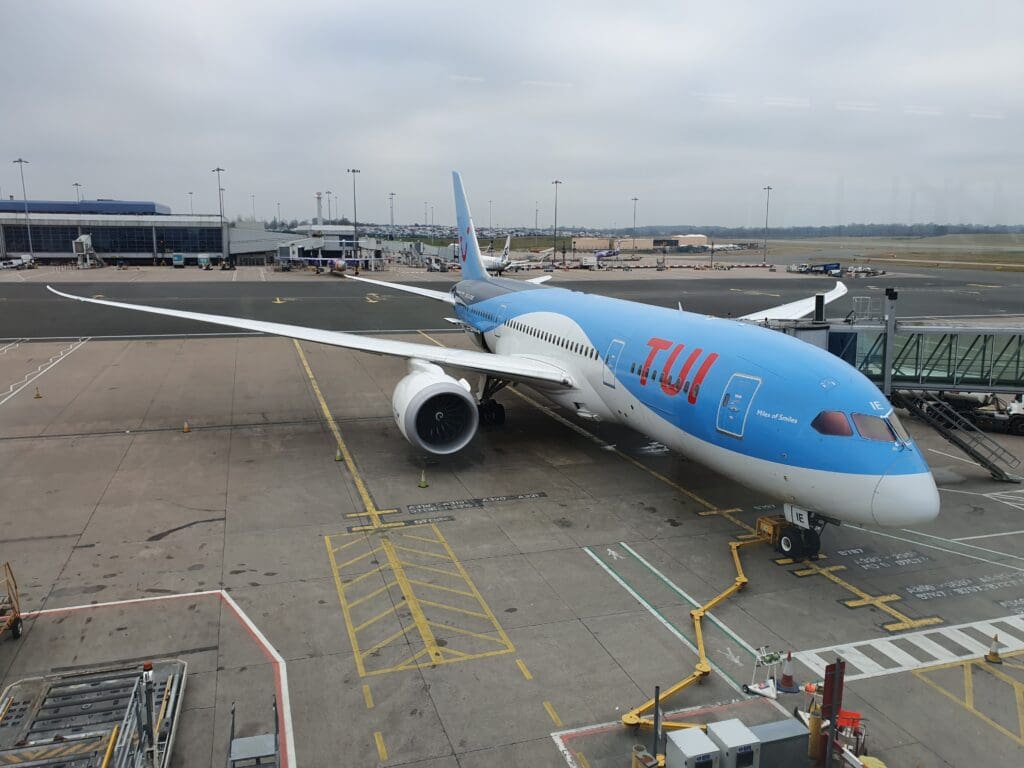
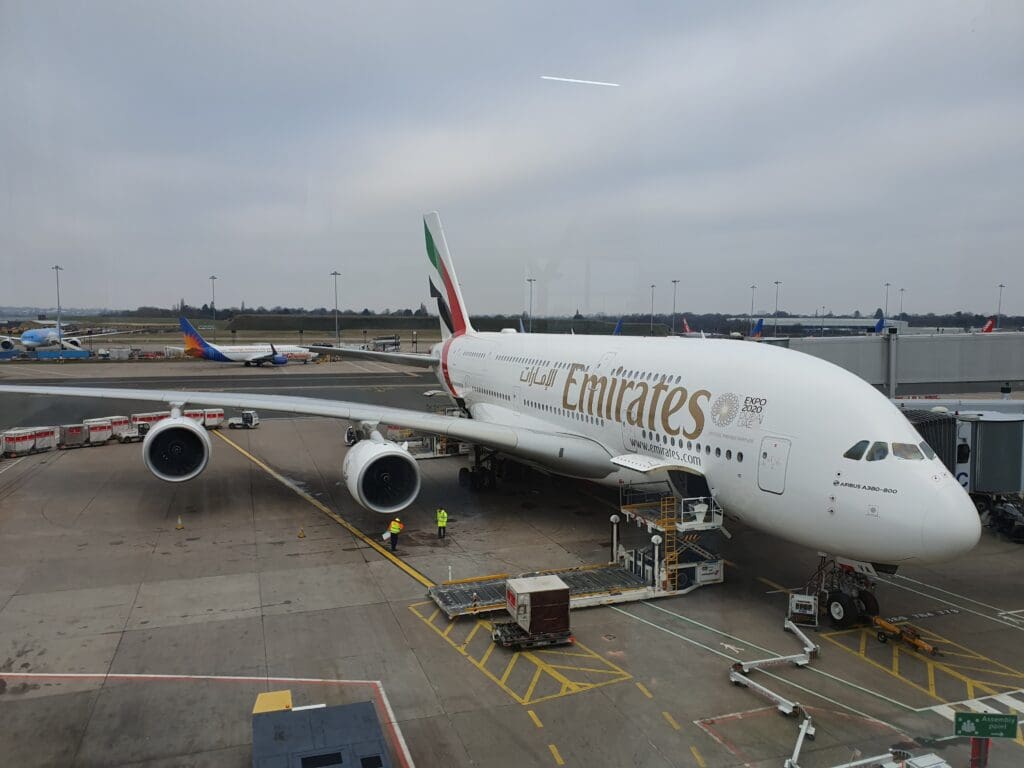
Having forgotten to charge my laptop before leaving my parent’s house and needing to do some work before the flight, I was forced to retreat to the terminal’s main area thanks to the newer pier’s apparent lack of plug sockets. However, even there, plug sockets were disappointingly hard to find. Eventually, I did find a socket in the seating area of M&S Food to Go. After purchasing a millionaire’s shortbread for 95p, I plugged my laptop in and did some work as I waited for my flight.
A quick look at Flightradar24 revealed that Airbus A318-111 F-GUGF would be operating the flight to Birmingham and, having taken off from Paris CDG 40 minutes behind schedule, this touched down eight minutes late at 1408 before making its way to Stand 58. Having made its first flight from Hamburg Finkenwerder in January 2004 with the test registration D-AUAJ, at the time of my flight, the aircraft was nearly 16 years old. After several months of testing, the aircraft entered service with Air France in early April 2004 and has remained with the airline ever since. Interestingly, since Spring 2010, the aircraft has worn Air France’s updated livery, with this being one of the first Airbus A318s to be repainted into this scheme. In the week before my flight, the aircraft had conducted 28 short hops in Europe, connecting Paris CDG with Bilbao, Birmingham, Brest, Copenhagen, Dublin, Florence, Geneva, London Heathrow, Manchester, Milan, Nantes and Zurich, covering at least 10,350 miles in the process.

Given the slightly delayed arrival of the inbound aircraft, I was a little sceptical that boarding would commence at 1415 as per the information given on my boarding pass. Nevertheless, not wanting to get left behind, as this time approached I vacated the cafe and made a slow stroll to Gate 58. As is the case at many of Birmingham Airport’s gates, boarding passes are scanned and passports are checked upon entry to the gate holding area, allowing for a streamlined boarding process. By the time I entered the holding area, it was standing room only and it appeared as if I was one of the last passengers to arrive at the gate. At 1420, an automated announcement rang out in English and French, announcing that the gate was about to close – this coming even though passengers could still be seen streaming off the inbound aircraft. Allowing for a range of connections, that afternoon the flight to Paris was codeshared with a f nine other airlines – specifically Air Austral, Air Mauritius, Atlasglobal, China Eastern Airlines, China Southern Airlines, Delta, GOL, Kenya Airways and Virgin Atlantic. Whilst the flight number of each respective airline was shown on the departure boards, only that of China Eastern Airlines was mentioned in the automated announcements. This was unsurprising given that a significant number of passengers appeared to be connecting to China Eastern Airlines’ evening flight to Shanghai Pudong.
A short time after arriving at the gate, one of the two staff members in charge of supervising boarding put up an Air France sign, directing those priority passengers in Zones 1 and 2 to stand on the right, and those passengers in Zones 3 to 5 to queue on the left. By 1425 disembarkation appeared to have reached its conclusion and only two minutes later, boarding was announced for those seated in Zones 1 and 2. Given the light load in Business, consisting of just two passengers, and the lack of passengers requiring assistance, only a minute later, those in Zones three to five were invited to board. When announcing this, all those seated in Row 15 and above were advised to board via the rear steps – this being rather welcome to me given the lack of decent photo opportunities at the gate.

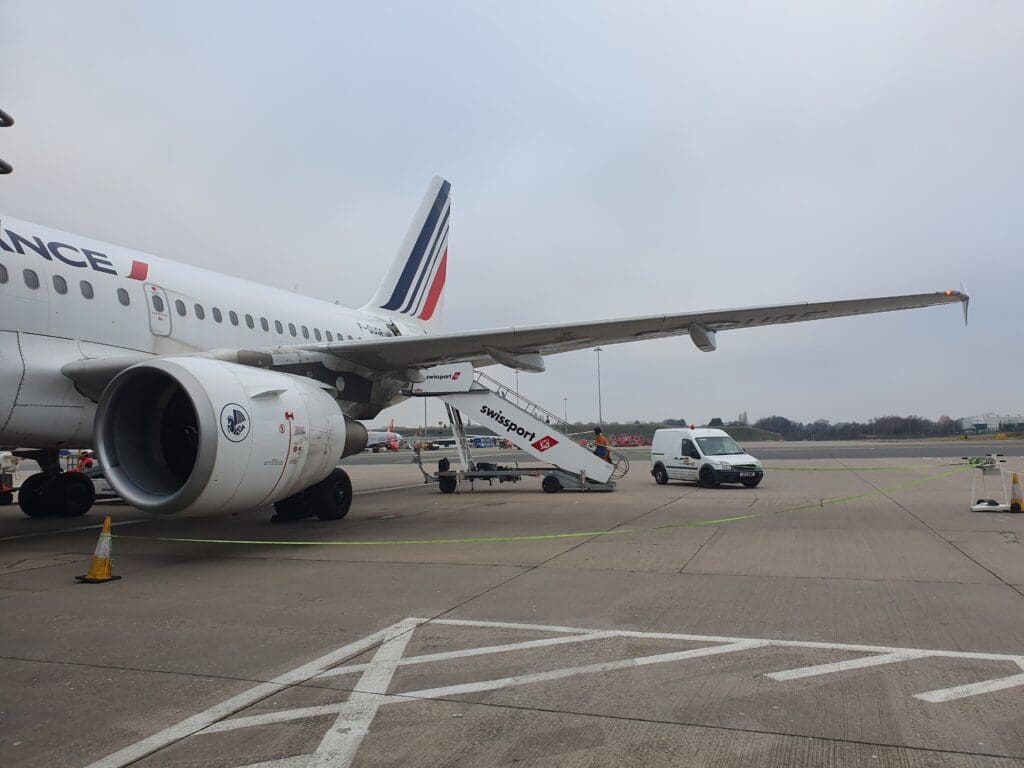



Following the stream of passengers, most seemed not to get the message about using the rear steps for boarding and continued down the jetway. However, I left this and headed down the stairs into the chilly January air. After snapping some photos, I made a brief walk around the aircraft’s port wingtip before arriving at the rear steps. Following a very short pause at the rear door, I stepped into the rear galley where I received a warm welcome in French from one of the three flight attendants. Given the lack of a bulkhead separating the rear galley from the cabin, I was immediately greeted by the sight of the aircraft’s incredibly thin-looking seats. These took the form of the Recaro SL3510, a type that is also used by International Airlines Group members British Airways, Iberia and Vueling.
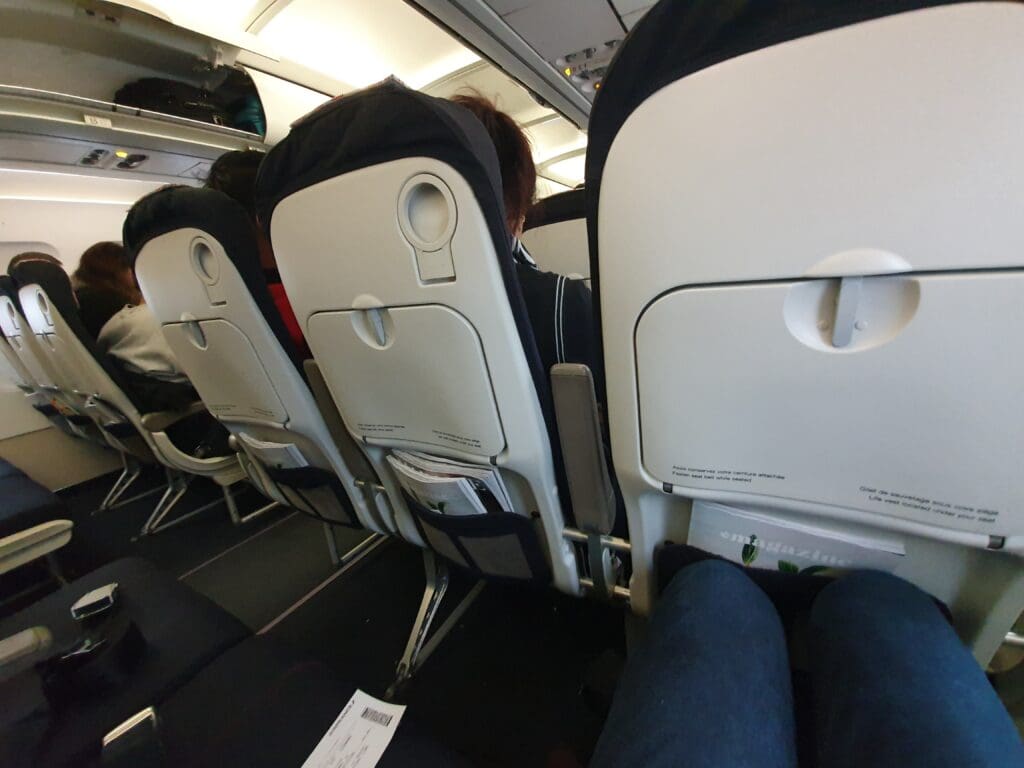
Each of the aircraft’s 131 seats was covered in a dark blue fabric and topped with a white faux leather headrest which featured a red pattern. A few moments after stepping onto the aircraft, I arrived at row 17, where I found a family occupying 17A, B, D, E and F, leaving me with no choice but to occupy the left-hand aisle seat. Without causing a fuss at my lack of a window, I put my bag into the overhead locker and took my seat. In the meantime, the boy to my left screamed for his father in Seat 17D – my offer to swap seats for the boy to get his wish was rejected. Instead, several sweets and other items were passed over me in an effort to calm the young passenger.
Despite the flight appearing to be around 90% full in economy, boarding was completed in a little over ten minutes and at 1440 the ‘boarding complete’ announcement was made in French. Seeing a completely vacant row in front of me, without any hesitation, I slithered forward into Seat 16F and made myself comfortable for the flight. As was the case with the area around Seat 17C, the space around Seat 16F appeared to be in a relatively clean condition whilst wear and tear was limited to a few splodges and a blurry window. Turning to the seat, whilst this was undoubtedly thin, I found it to be reasonably comfortable for a short flight. Meanwhile, legroom-wise, these were mediocre, neither terrible nor spacious but acceptable given the flight’s duration. However, had I been flying the jet to say Istanbul, I may have ended up with a few more complaints. Last but not least, the seat pocket contained a copy of the January 2020 edition of Air France’s inflight magazine, appropriately named Magazine as well as their larger Madame magazine. Hinting at the presence of a light-fingered aviation enthusiast in Seat 16F on the inbound flight, notably, neither a sickbag nor a safety card could be found in my seat pocket, however both could be found in that of the neighbouring seat.
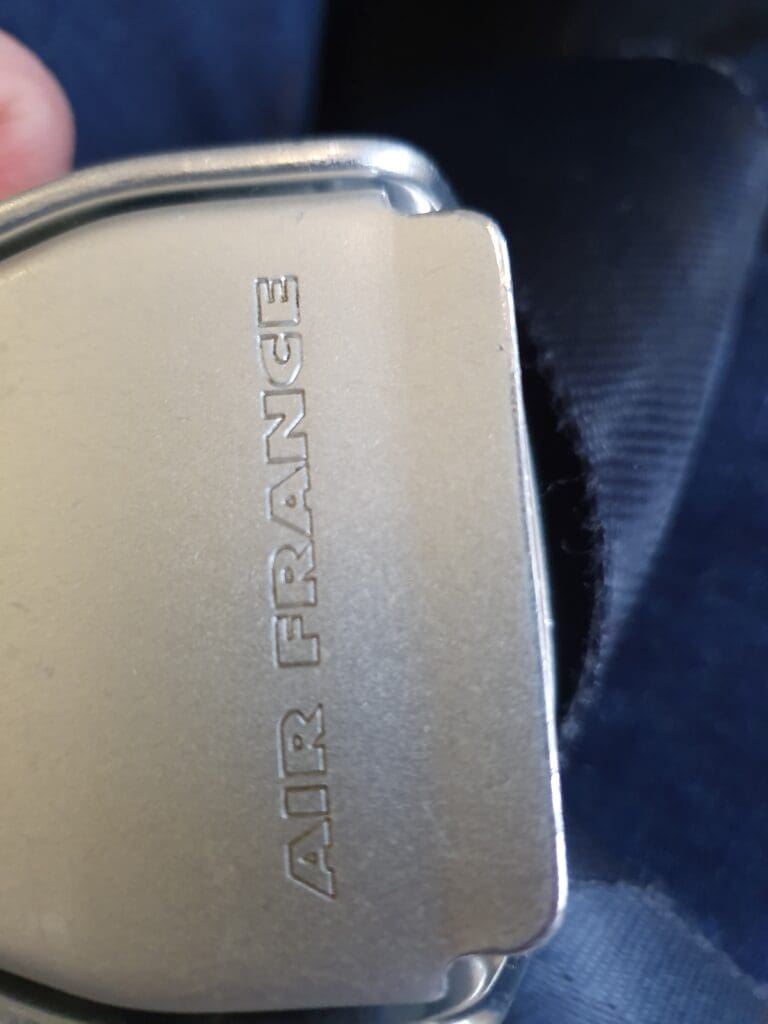


Once all onboard had settled in for the flight to Paris, the aircraft fell eerily quiet, with no announcements, no boarding music and no activity within the cabin. Meanwhile, the cabin soon became uncomfortably hot as we waited for the engines to start and for things to cool down. Just after our scheduled departure time, the Purser conducted a joyful welcome announcement in French and English, and immediately afterwards a safety demonstration was undertaken. This consisted of two flight attendants working through the actions, whilst a third read through the safety instructions. Midway through this, the Airbus could be felt being pushed back away from the terminal at which point our two CFMI CFM56-5B8/P quietly powered up into life ready for the short journey to France.
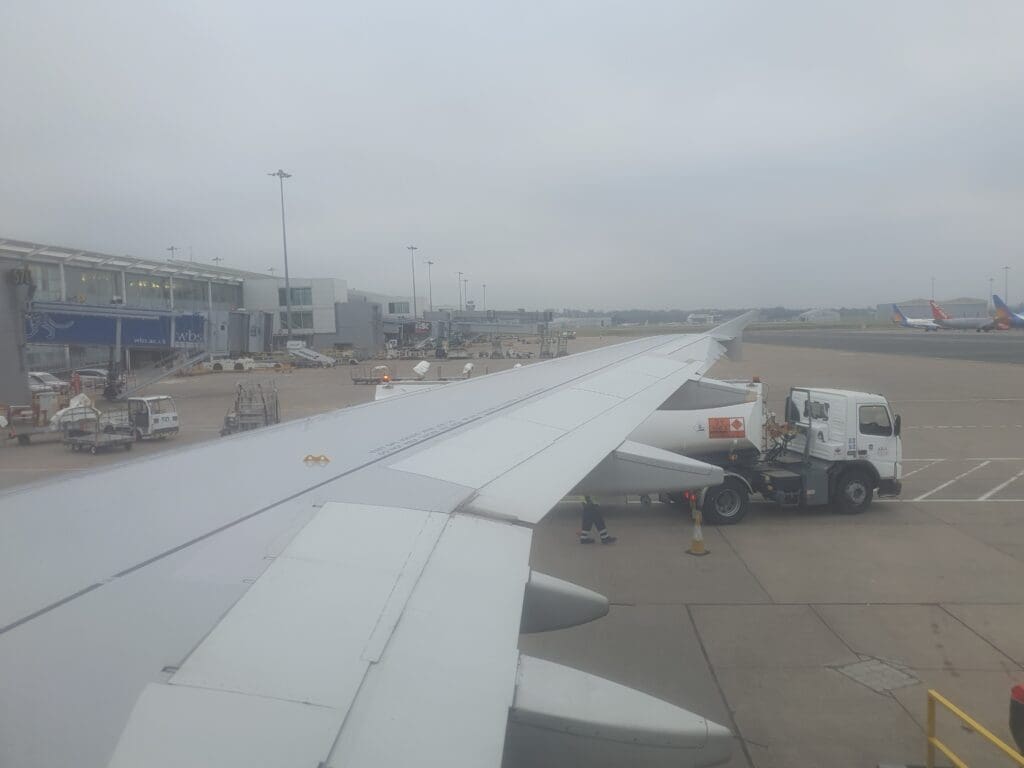
Once the flaps had been partially extended, the Airbus commenced its quick taxi to the end of Runway 15. This journey took us past the long line of aforementioned Jet2 jets alongside the TUI Airways Boeing 787-9 Dreamliner which would later carry some lucky holidaymakers across the Carribean to Bridgetown. From the apron, the aircraft journeyed past the fire station and headed parallel to the long grassy mound. Without holding, ‘Airfrans 67 Golf Papa’ was cleared to enter the runway and at 1457, the two engines spooled up as we commenced our powerful rolling takeoff.
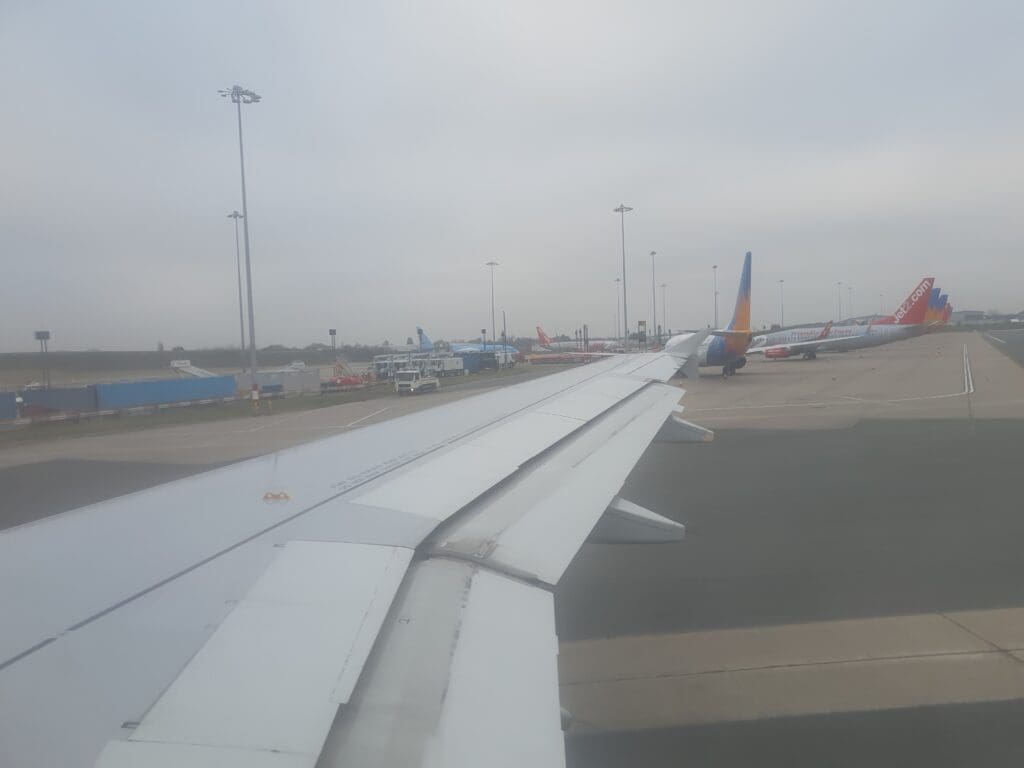
After what seemed like a very short takeoff roll, the aircraft quickly rotated upwards into Birmingham’s overcast skies, doing so before reaching the large STS Aviation hangars on the western side of the airfield. As we soared into the skies, I was offered a good view of Birmingham Airport’s original terminal, where unusually, just one aircraft could be seen on the ramp there, coming in the form of a Flybe Dash 8 Q400. Unfortunately, almost as soon as we had passed over the airport’s perimeter fence, the Airbus rose into the clouds. Upon breaking through these, I was offered superb views of the wintery afternoon skies which would have made for some nice photos had the windows not been so blurry!


Having departed into the southeast, only minor changes in heading were required following our departure to put us on course for Paris as we climbed over the West Midlands. After just twelve minutes in the air, the Airbus gently levelled off at its low cruising altitude of 27,000 feet as we sped over the Chilterns towards the world-famous town of Slough. At this time, the seatbelt signs were extinguished and I decided to make a quick trip to one of the aircraft’s lavatories. Unlike the larger Airbus A319 and Airbus A320, the Airbus A318 features just two lavatories instead of three. One of these is located at the front and is thus reserved for those in Business, whilst the other is located at the rear of the aircraft. Making my way inside without any queuing, this served its purpose and whilst lacking in any particular niceties, this was clean, in good condition and stocked with the basics.
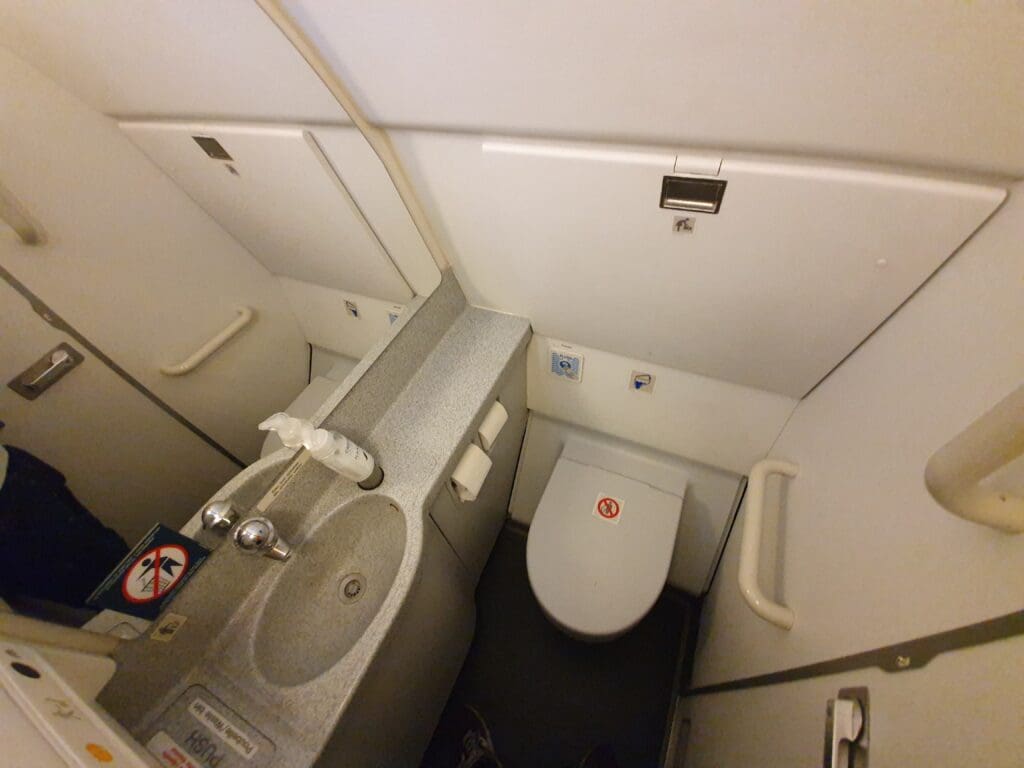
Upon returning to my seat, that afternoon’s onboard service commenced, with two flight attendants responsible for undertaking this in Economy, whilst the Purser tended to those in Business, which that day took up the first two rows of the aircraft. At this point, the Captain performed their welcome announcement in French and English. During this, they informed passengers that we could expect an on-time arrival in Paris and that the weather was foggy with a temperature of three degrees before closing this by wishing us all a ‘very nice year in 2020’.
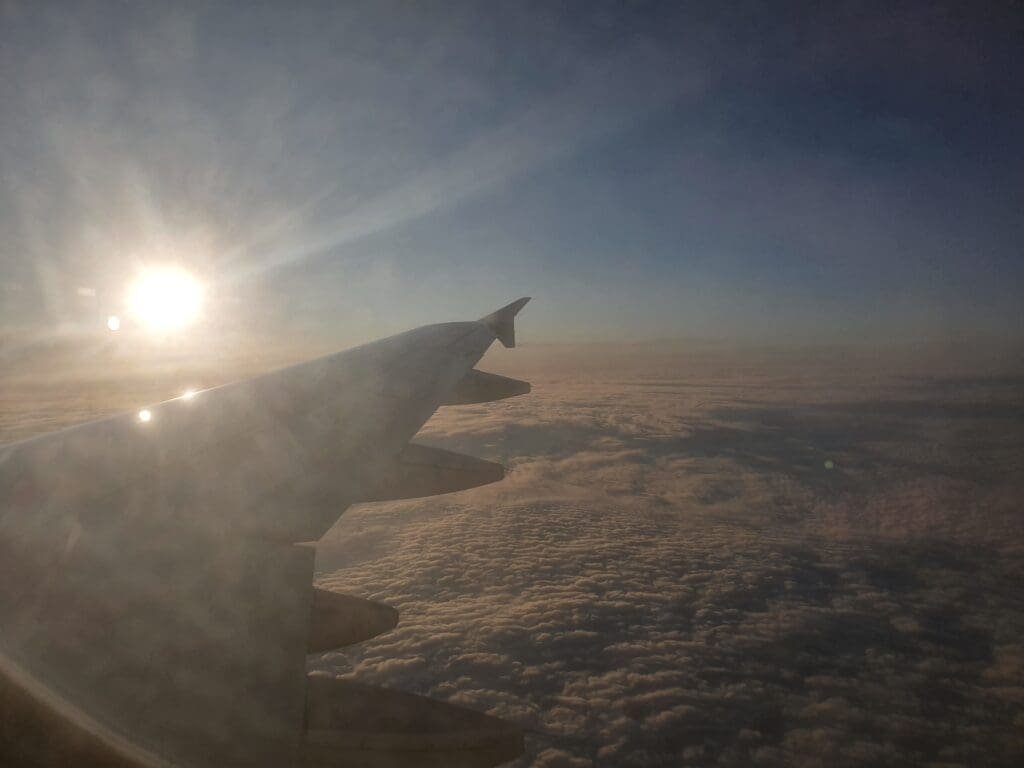
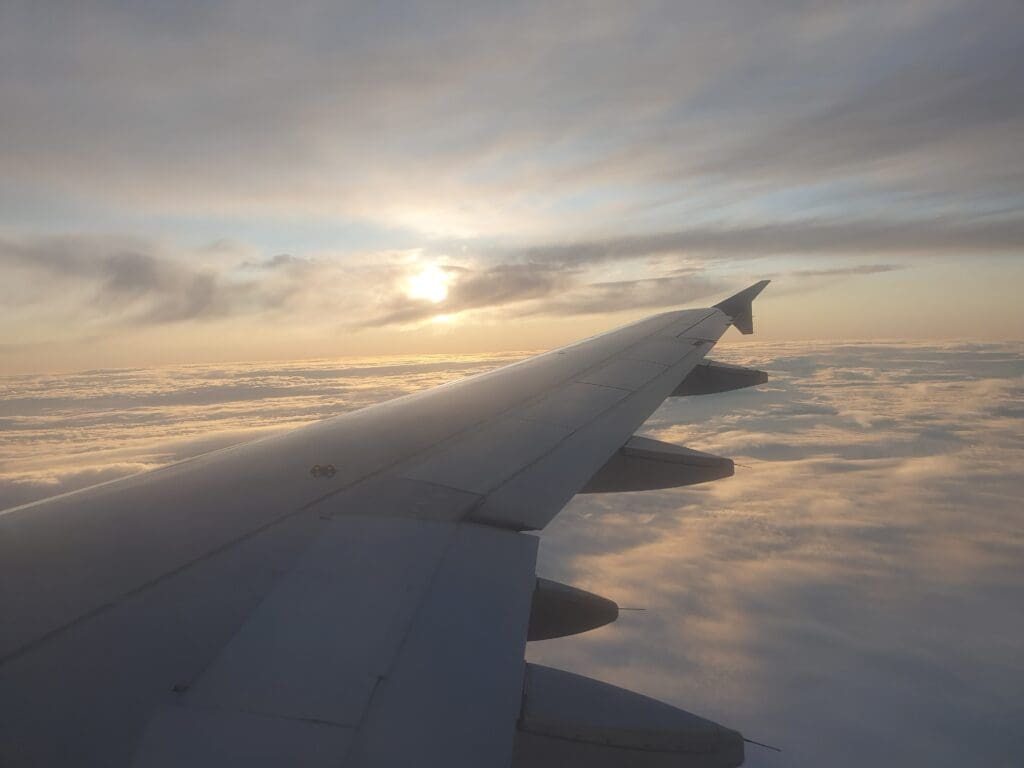
Around 10 minutes after the onboard service commenced, I was handed an Air France branded serviette and a small packaged cake, a moelleux pomme to be precise, and was asked for my choice of drink. Opting for an orange juice, I was handed a small 150ml can of Minute Maid juice along with an Air France branded paper cup. Whilst rushed given the short flight time, the service was conducted politely with a smile, so I was left with no major complaints. Admittedly, this service was no rival to the Lufthansa sandwich or the small box served on KLM’s short intra-European flights, nor was it as substantial as the wrap I had received on my Air France flight from Paris CDG to Heathrow a little over two years earlier. However, the cake was delicious and being free, I could not complain about this offering!

With little to see outside through the battered window, as soon as I finished the snack I turned my attention to the two inflight magazines. Focusing first on Magazine, this is split into four sections ‘Ici et Ailleurs’ (here and elsewhere), ‘Boussoles’ (compasses), ‘Correspondances’ and Air France News – the latter two sections needing no translation! Content-wise, this is your usual inflight magazine featuring a wide range of articles on just about everything and is heavily laden with advertisements for a range of goods and services. Meanwhile, Madame contained a similarly diverse selection of articles on an array of topics.
With little time to rest on this short sector, as soon as the crew finished distributing the snacks and drinks, the rubbish collection service commenced from the front of the cabin. After crossing over the British coastline between Brighton and Eastbourne, only 23 minutes after departure, our aircraft could be felt commencing its descent. A few minutes later as we neared the French coastline around Dieppe, an announcement was made regarding our arrival – this involved the usual pre-landing warnings regarding seatbacks, tray tables, seatbelts and window shades, as well as a reminder to leave all luggage onboard the aircraft in the event of an evacuation. As we sank downwards, the scenic dusk scenes continued outside as the crew passed around the cabin making sure all was secured for our arrival.
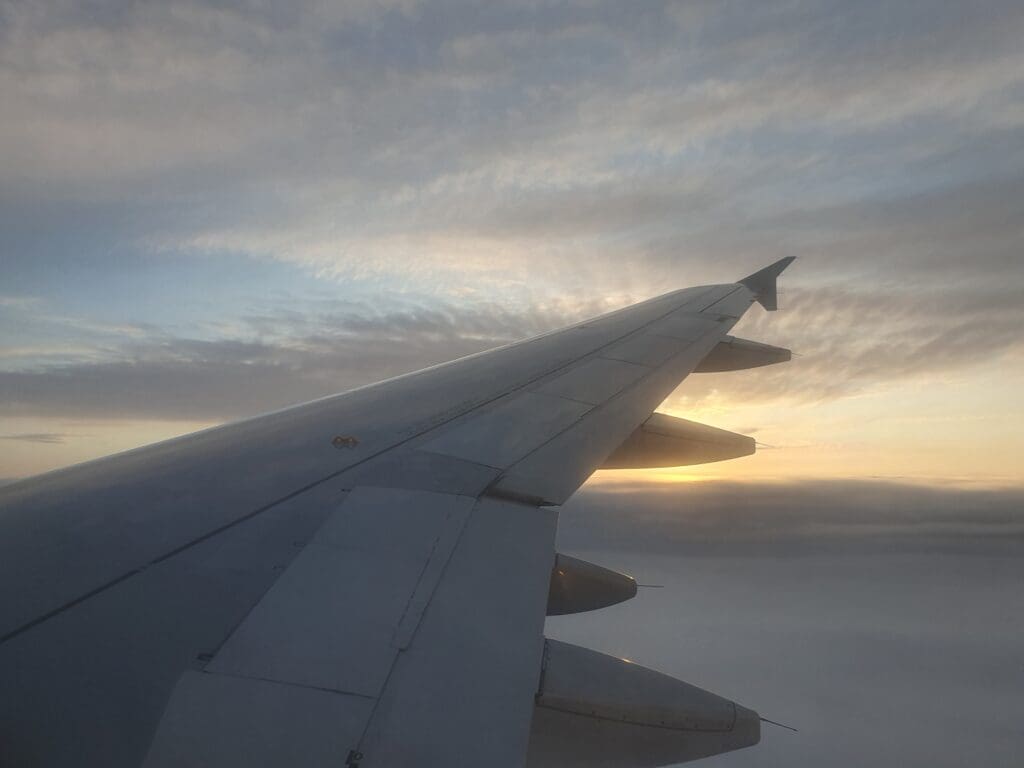
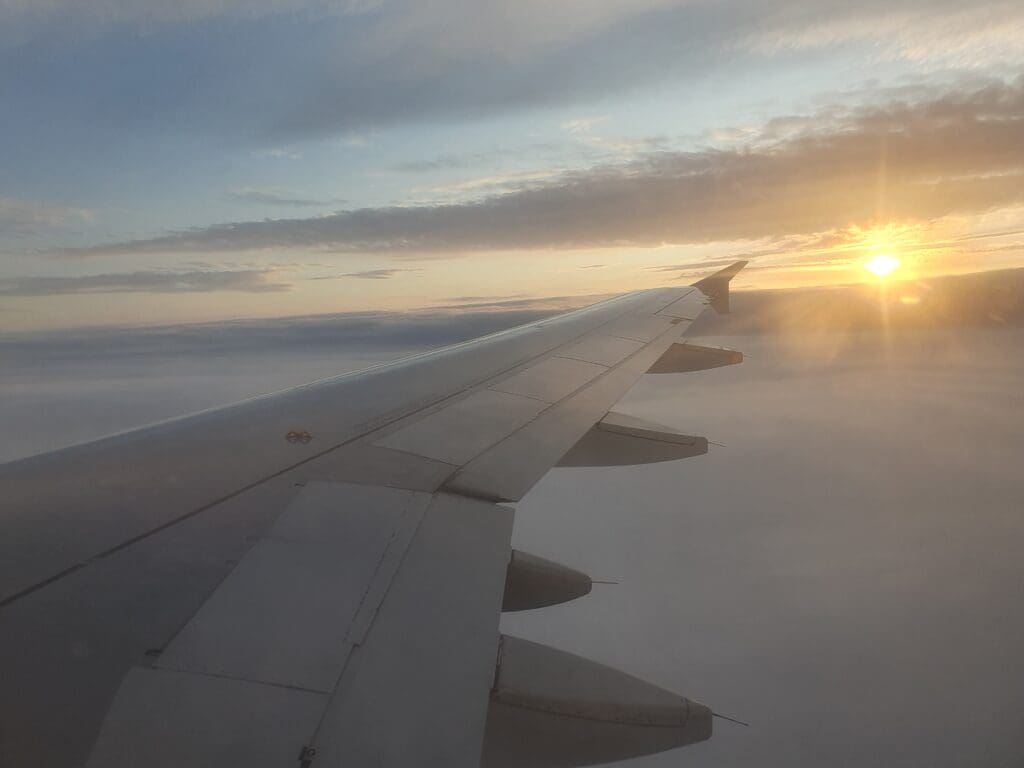
At 1638, the seatbelt signs were reilluminated as we passed through 10,000 feet over the Parc Naturel Régional du Vexin which lies to the Northwest of Paris. This was followed by one final quick rubbish round before the crew strapped themselves into their seats. Outside, nothing could be seen as we headed towards Paris before we gently sank into the tops of the clouds. At 1645 French time, our aircraft gently banked left to put us on approach to Paris CDG’s Runway 09L and we passed over the town of Cergy at an altitude of 3,500 feet whilst our flaps were lowered to 15 degrees as we sank down into the clouds. Eventually, our gear was extended and the flaps fell fully indicating our imminent arrival, however, given the thick fog, the ground did not appear until only seconds before arrival.
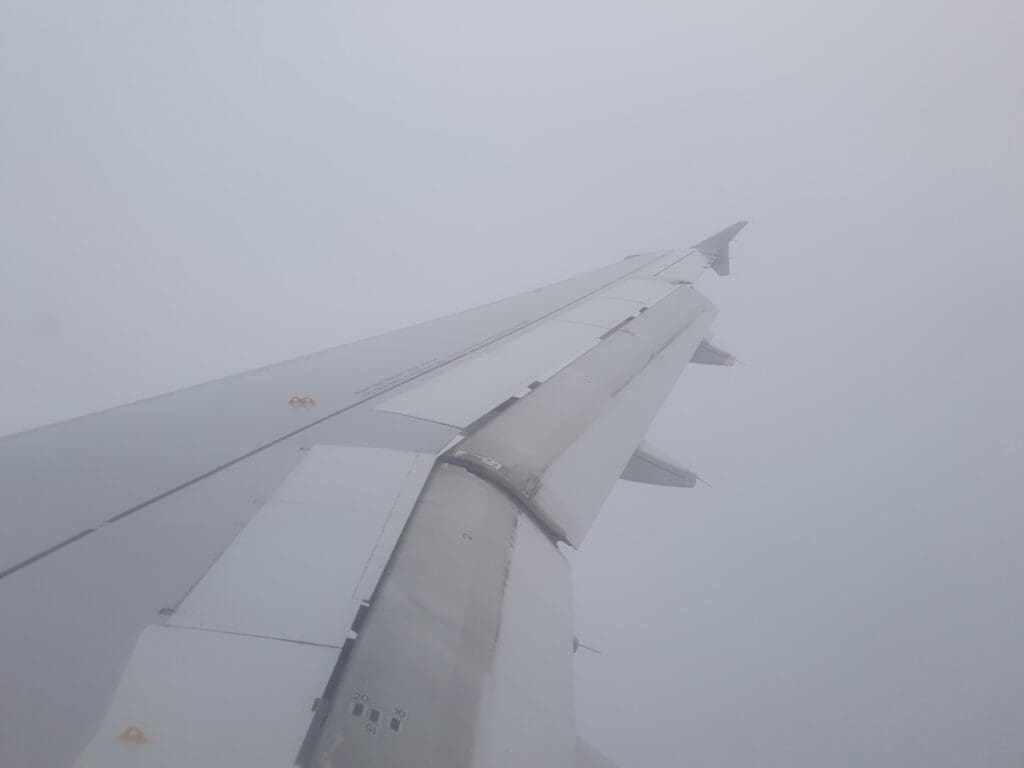
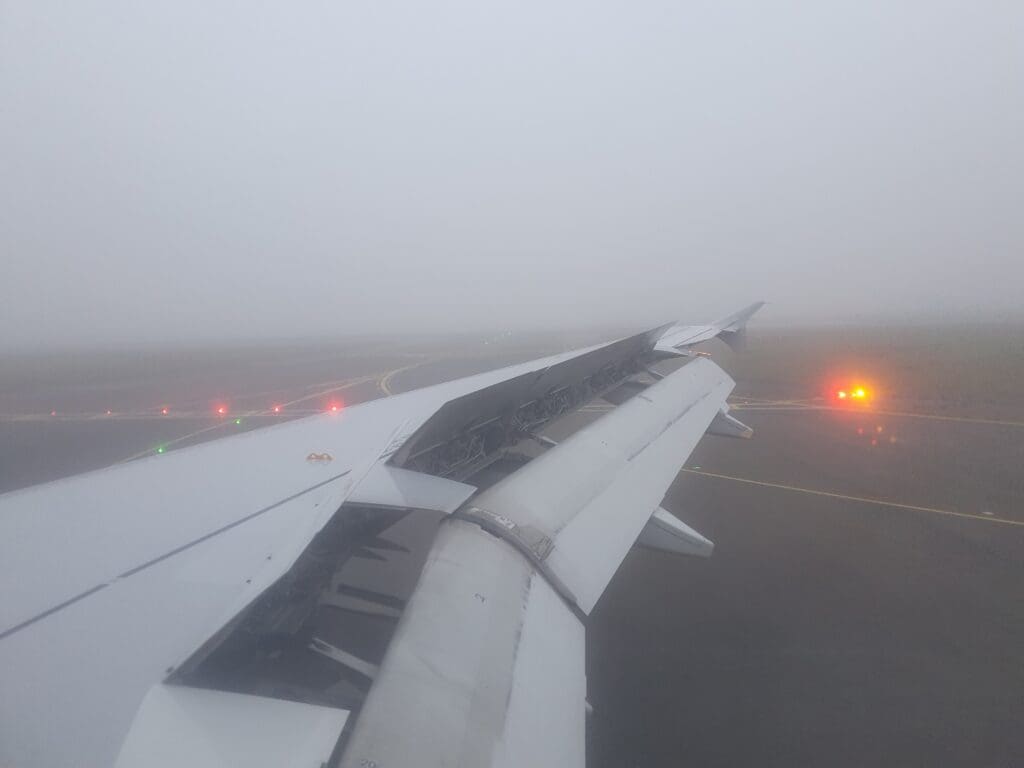
At 1653, 56 minutes after leaving Birmingham our aircraft made a gentle touchdown on Paris CDG’s Runway 09L, our arrival was followed by some gentle braking that saw us exit the runway a fair way towards its end. As we taxied off, the Purser welcomed everyone to Paris, informed us of the local time and thanked us all for flying with Air France before Vampire Weekend quietly filled the cabin. Quite rightly, our taxi to Terminal 2E was rather slow and cautious, and we soon found ourselves waiting for several minutes to cross Runway 09R along with an Air France Airbus A319 that had just touched down from Munich. Once across the runway, we headed towards the vast expanse of Terminal 2. Given the thick fog, only a small handful of aircraft could be seen during the taxi, however, interestingly these came in the form of every single widebody jet in Air France’s fleet as we passed Terminal 2E before pulling up to Stand E13 next to a small Flybe Dash 8 Q400 at 1704.
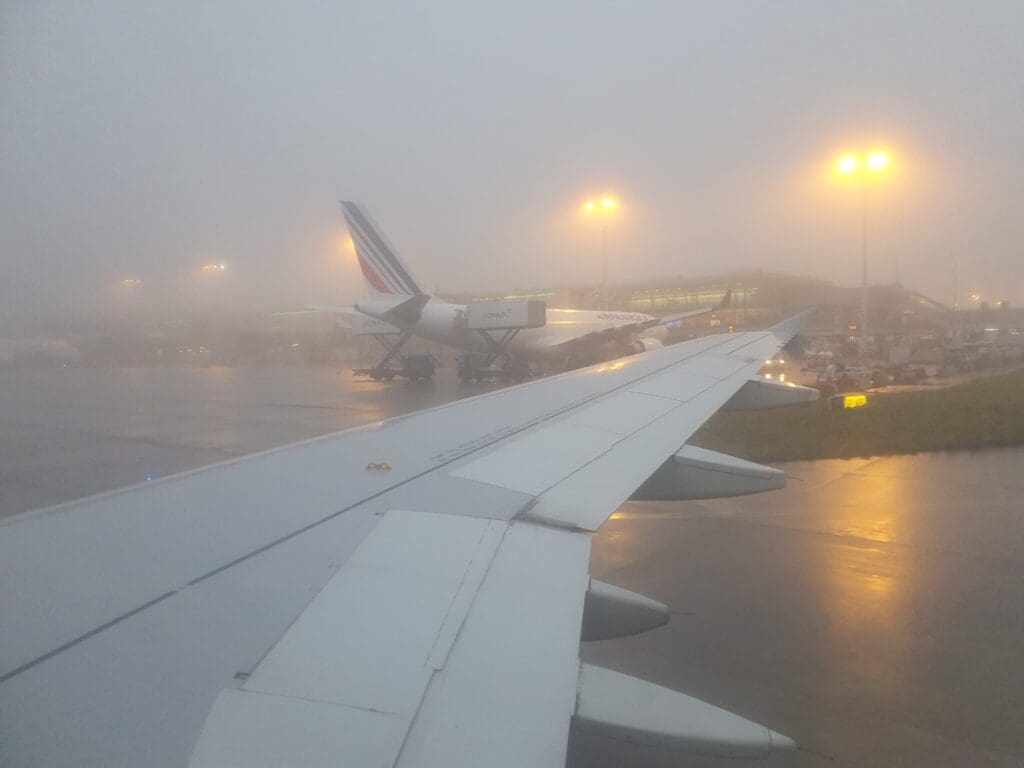
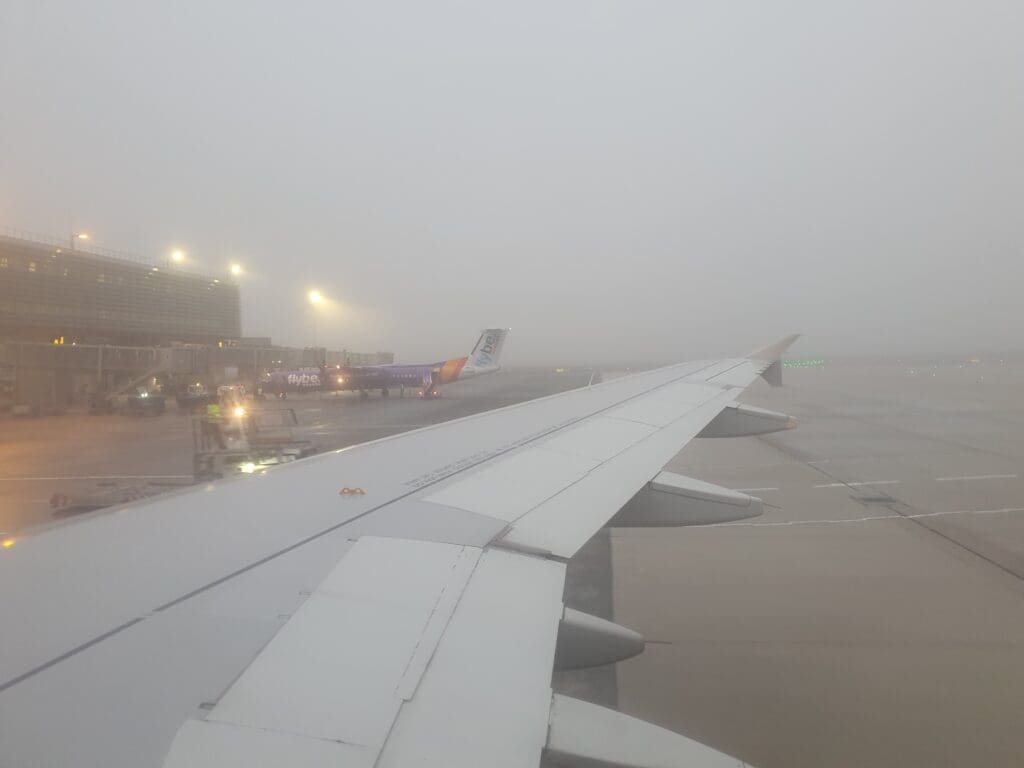
Once the aircraft pulled into the stand, all fell quiet momentarily as the engines were shut down. This silence was broken moments later by the loud and persistent ‘squeaky’ Airbus sound that filled the cabin for a prolonged amount of time before gently fading away. A few minutes after pulling up to the terminal, the jetway was commenced and disembarkation commenced. After some shuffling forward towards the front of the cabin, I thanked two-thirds of the cabin crew members and stepped off onto the cold jetway and into the rather (temperature-wise) cool terminal. Once I arrived in the terminal, I followed the crowds of passengers from my flight along a rather uninspiring corridor that delivered us to the station. Despite just missing a train, I did not have to wait long for the next main terminal-bound departure and I soon stepped aboard an almost empty train.
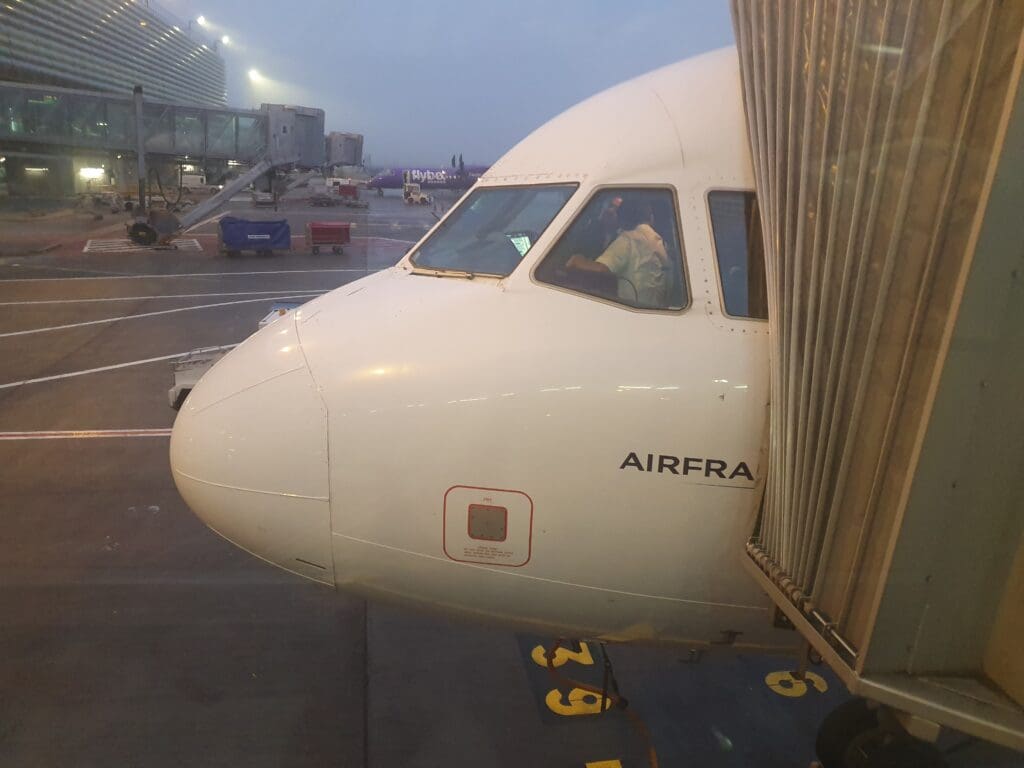
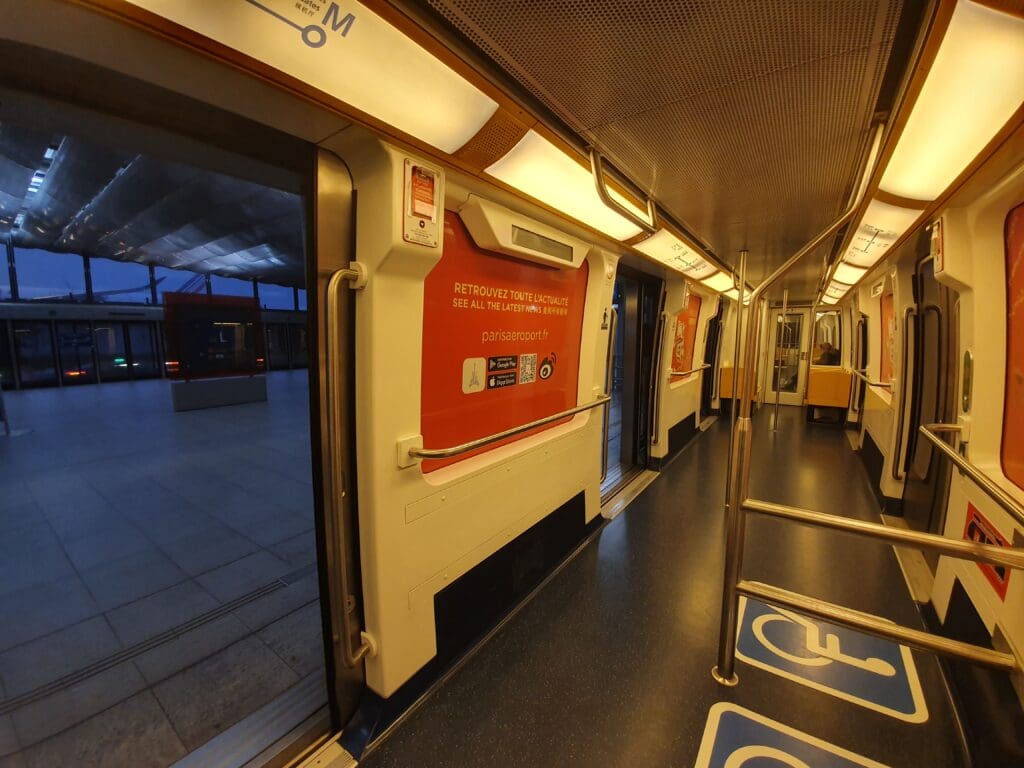

Unsurprisingly, by the time I arrived at immigration, it seemed as if only a relatively small number of passengers from the Birmingham flight intended on entering France, with the majority of passengers connecting onto long-haul international services. Nevertheless, with plenty of early evening arrivals, the immigration area appeared to be rather full. Holding an EU passport, I was pointed in the direction of the e-gates, which, with only half operational, featured a rather long queue. However, a few moments after joining this, I was sent away to one of the manned desks in an attempt by staff members to reduce queues. Within a couple of minutes of waiting, I handed over my passport to a typically stony-faced immigration officer, who, after a quick scan of my passport handed this back to me. After a quick ‘merci’ I proceeded into France, heading down the escalators to the cavernous baggage claim area, passing straight through this thanks to my lack of checked-in luggage.

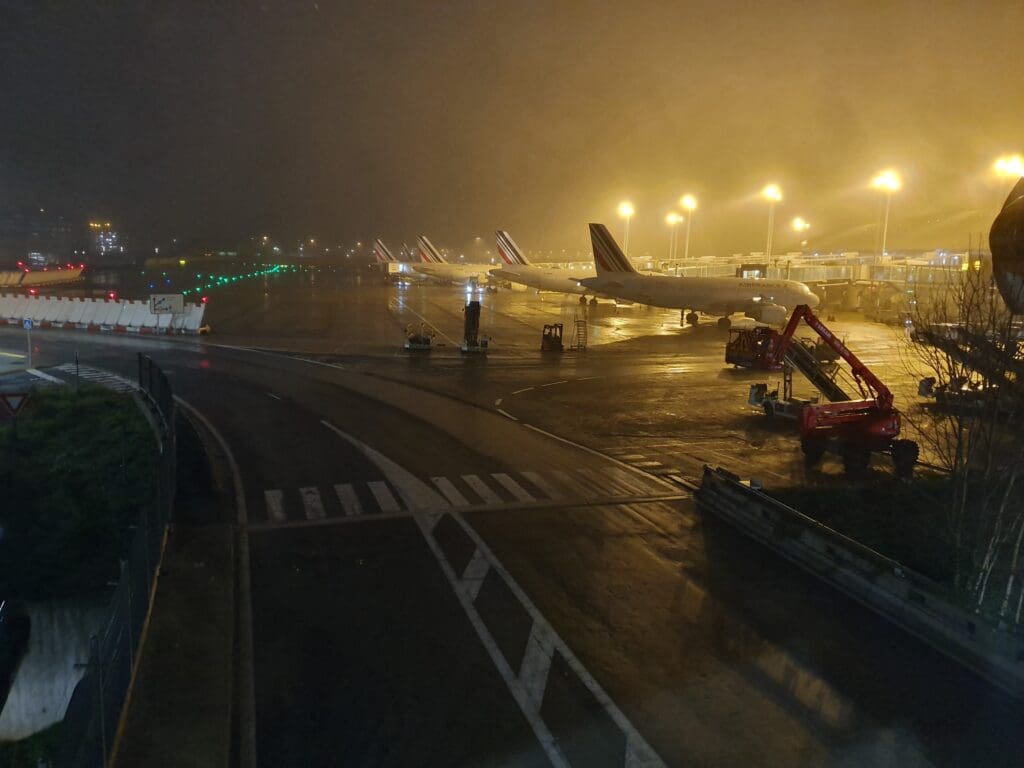
Having arrived at one of the satellite piers of Terminal 2E, all-in-all my transit from aircraft to landside arrivals area was not incredibly rapid, especially given the fact that I had arrived on a flight from the EU (albeit a non-Schengen country). Over thirty minutes after I had disembarked the aircraft, I arrived at the airport’s SNCF station, where, due to the ongoing strike I discovered I would have to wait 28 minutes wait for the train to Paris. However, to be honest, I was lucky that I had arrived on a day when the RER was operational, if only as far as the city centre. After a quick walk around, I descended to the platforms and boarded the waiting Gare du Nord bound train. Eventually, this pulled away from the station and commenced a slow journey to the centre, stopping not only at every station but seemingly at every signal as it headed southwards towards the city, eventually arriving around an hour later.

Summary
All in all, my experience with mainline Air France on this very short hop had been positive. The crew was friendly, polite and welcoming, the aircraft was comfortable enough and in a reasonably presentable state and I had been delivered to Paris on time and in one piece. Meanwhile, I have to give credit to Air France for their provision of a complimentary snack service!


